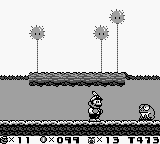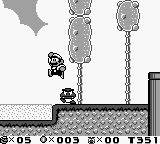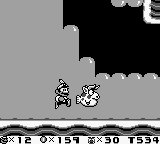Super Mario Land 2: 6 Golden Coins

- Japanese release in October 1992
- North American release in November 1992
- Asian release in 1992
- European release in January 1993
- Brazilian release in 1993
- Australian release in 1993
- North American release in May 1996
- North American release in November 1999
- Player’s Choice Re-release
- Japanese release in March 2000
- European release in 2000
- Game Boy Nintendo Classics
- Developed by Nintendo
Weird

To me, nothing says summertime like Super Mario Land 2: 6 Golden Coins. I never had the game when I was a kid but my cousins did. Since I only saw them during the summer when our families would camp together on the family lot, I would borrow the game from them during the sunny summer months. Being a better player, I would get through the game unlocking for them the levels they couldn’t reach. I was kind of the Game Boy idiot savant; all my cousins would dump their games on my lap to unlock stuff for them. In hindsight Super Mario Land 2 is laughably easy. When you’re a child though you have terrible hand-eye coordination. It makes everything more difficult but more interesting. Including this game.
And interesting it is! It’s again, like the original Super Mario Land, made by Gunpei Yokoi’s division in Nintendo. Let’s get it out of the way: Mario Land 2 is a great game. Lots of fun levels, plenty of interesting surprises, nothing is egregious with the game easy enough for everyone to enjoy. That being said, this game is weird on so many levels. It’s essential to me for that: the many ways Super Mario Land 2: 6 Golden Coins is strange while staying a competent platformer worthy of the most recognizable video game character.
Weird Release
Super Mario Land 2: 6 Golden Coins is only the third game on Game Boy to have the name of Mario in the title: Super Mario Land and Dr. Mario are its two predecessors. So what was ultimately the most recognizable game character was seldom seen on Game Boy. He was featured as a guest character in many titles (he was the referee on the Game Boy version of Tennis, the paddle controller in Alleyway) but Nintendo really parcelled the release of Mario games. He was Shigeru Miyamoto’s character, and he oversaw all the major games featuring him. The team responsible for Mario clearly had no time to make Game Boy games (Miyamoto’s EAD division was very busy making Super Nintendo titles) so it fell to R&D1 to use him on Game Boy.
Looking at Super Mario Land 2, I can’t shake the idea that someone at Nintendo (most probably our favourite bespectacled supervilain Nintendo president, Hiroshi Yamauchi) told Yokoi’s team to put something like the brand new Super Mario World on Game Boy. The only Mario platformer on Game Boy was getting very long in the tooth by 1992: Super Mario Land was an analogue of Super Mario Bros. that used very small sprites. Read my article on Super Mario Land to read about its design. Suffice it to say, those smaller sprites were never impressive and platformers on Game Boy were now very successful at using console-sized sprites. Mario’s time to grow up on Game Boy had clearly arrived. A comparison between the Land sprites and the Land 2 sprites.
A comparison between the Land sprites and the Land 2 sprites.
The game is a sibling to Super Mario World, sure, but the fine people at Yokoi’s R&D1 did not strictly ape the Super Nintendo title; they made a game all their own.
Weird Design
Each early Mario game has a very specific idea about its design. Since Super Mario Land 2 is clearly meant to emulate Super Mario World on Super Nintendo, we have to look at its overarching idea about level design to understand what’s happening. Super Mario World was built on the idea that you are exploring a strange new land, Dinosaur Land, taking the time to discover new challenges and enemy types. It might sound weird to think the game best remembered for its speedy cape acrobatics and running with Yoshi is ultimately about a leisurely stroll but that’s really what the game is about. Compare the game with its predecessor: in Super Mario Bros. 3 you have eight worlds and the levels within those eight worlds are all of a similar type. Each world is thus a theme. But there are weird outliers, levels which seem disconnected from the overarching theme of the world. And the levels are very short. You don’t really feel like you’re exploring, discovering. You’re going through a gauntlet of short, themed challenges. And this fits within the conceit of Super Mario Bros. 3 that Mario and Co. are acting out a play. That the platforms are stage-play elements bolted on to the background. That you’re fighting against a bolted-on level, not a functioning cartoon environment. Super Mario World has a more deliberate pace, putting you in gameplay situations that last for a longer period of time. They obviously decided to implement fewer ideas, but explore those ideas more. The levels are long, usually have one single gameplay idea and explore that idea to a natural conclusion. Super Mario Land 2 is trying to do a very similar thing. This more deliberate pace, slower exploration of a gameplay idea lent itself very well to the Game Boy. R&D1 could use this idea, make Mario and his enemies’ sprites bigger and build a world that felt fun to traverse with such big sprites compared to the previous Mario Land game.
Weird Camera
I’ve been fascinated since the beginning of this project by the choices developers made to address the Game Boy’s limited resolution. What did R&D1 do to deal with a bigger Mario sprite? They basically did what every other developer had done and made the camera move during jumps while adapting the world around your character to better fit this bigger character.
Since the camera moves with every jump, it produces ghosting with everything on the screen. There’s no escaping it, but since you already get ghosting from horizontal movement, we all lived with it. To alleviate the ghosting the backgrounds are kept simple. There’s no big secret to it; you’ll get ghosting on every pixel from any scrolling so you have to keep a healthy dose of whitespace. The other, less obvious thing they did to reduce the impact of ghosting is keeping hazards far apart from one another. Enemies don’t gather, they don’t hang around together in groups, they’re each and every one of them pretty much alone. So much so that you tend to have only one enemy on the screen at a time. Console Mario games oftentimes have situations where you’ll jump from enemy to enemy to clear a hole or a hazard. It does not happen in Super Mario Land 2. Gauntlets of multiple varied enemies simply do not exist in this game.
Gauntlets of multiple varied enemies simply do not exist in this game.
It’s not a strict rule, but it’s clearly intentional; hazards tend to be far from one another to give you ample time to decipher and react to them. You don’t want to have to try and make sense of a giant glob of ghosting, you want to have to figure out a small glob of ghosting. It definitely helps with the smaller resolution of the screen but it’s not perfect; I distinctly remember having a hard time reading enemies in Mario Land 2 when I was a kid who had only seen the game through a DMG’s screen. But it made sense, Mario on Game Boy finally looked like every other platformer on Game Boy instead of being a weird outlier. I mean, Mario went from using four pixels for his nose to an impressive twelve whole pixels. Twelve!
Weird Style
The jump from four pixels to twelve for Mario’s nose (twelve!) is emblematic of what they did to our beloved plumber’s world. The small team of developers at R&D1 were no longer stuck trying to make iconic Mario enemies and locales work in such a small size. They could artistically interpret the characters and environments that made Mario famous. In Super Mario Land, Goombas looked like the shadow of a Goomba. In this game they have a sprite big enough to convey a specific style. They have big eyes and eyebrows; they’re really expressive.
The enemies they created are weird. It’s a cavalcade of enemies that don’t fit. Vampires, sharks, the three little pigs, chibi Jason, the torture ball Vader uses on Leia in Star Wars, everything that doesn’t make sense in a Mario game is there, mixed in with the classic enemies. Miyamoto’s Mario lives in a cohesive Disney cartoon; R&D1 put him in a Don Bluth production! Ultimately, it’s not a major issue. You just accept the weirdness, and you roll with it. But upon closer inspection it does feel out of place. Hindsight is twenty-twenty but it feels to me like they were hitching for the satirical approach to character design that permeates Wario Land. The bug-eyed bird you fight on top of Tree Zone looks like the son of the vulture from Wario Land.
Mario Land 2 feels looser, less laser-focused than the other Mario games. The controls are floaty and extremely forgiving. It clearly was not made by Miyamoto, the master of laser focus.
Weird World-Building
By 1992, Mario was finally a properly managed brand. Gone were the heady days of Captain Lou Albano or the crappy Donkey Kong cartoons of the ’80s. Mario was still reeling from those strange decisions for sure. Reruns of those shows ran everywhere and pallets of the disgusting (from what I’ve heard) cereal were still hanging about. The imbecilic Super Mario Bros. movie starring Bob Hoskins would not come out until 1993. But the worse was over: the brand managers at Nintendo were reeling from all the misplaced trust they put into other creators and would not make the same mistake again. And again. And again. I mean, let me stop my train of thought for a second to highlight how many terrible people were entrusted with the golden goose. The aforementioned cereal made by Ralston Purina (the same company as the animal food). The terrible toys made by Nasta, a toy maker so forgotten it doesn’t have a Wikipedia article or a mention on websites dedicated to 80s toys. DiC’s cavalcade of cheaply made cartoons, written by old men who couldn’t care less about Mario.
The point I was making was that all the people at Nintendo had finally seen Mario for what he really was: a global icon who needs to be managed like the biggest star in the world. Whitney Houston doesn’t participate in shitty low-budget kid shows with washed-out wrestlers. Why should Mario? They finally realized he’s above that (or the Nintendo headquarters in Japan forced the people at Nintendo of America to come to grips with that fact) so it gradually stopped. But what about the people making the games?
There is obviously now a coordinated effort to get Mario in high-quality productions. Mario is not above being in other companies’ games. Think of the Olympic-branded games from Sega and Mario + Rabbids Kingdom Battle. They clearly have to be of a certain type: they’re either the franchises that have existed for a long time (the sports games, Itadaki Street, Mario Party) or very high quality. But what about the internal Nintendo teams?
Daddy gets a pass. The people reporting to Miyamoto at EAD can do whatever they want with the little dude. They put Mario in a go-kart, they started him golfing. But what about the other teams? That’s where we land at Super Mario Land 2. It was made by people at R&D1, who never reported to Miyamoto. It features weird out-of-place elements, just like the first Super Mario Land. Cheeky sharks. Bug-eyed birds. A level featuring the Lego ripoff R&D1 made in the ’60s, the N&B blocks. A whole zone that’s a giant statue of Mario himself (with a level filled with balls right in the crotch of Mario’s statue). Nothing fits with the modern look of the Mushroom Kingdom because the game did not have Miyamoto’s point of view of what fits in a Mario game.
The closest feeling is New Donk City in Super Mario Odyssey. Even though Odyssey was made with Miyamoto, I’d argue they did something that did not obey their own internal logic when Mario exists next to correctly proportioned humans who tower above him. Just like it makes no internal sense that there are cowfish swimming in sap inside a giant tree on Mario’s private island.
There is, however, one thing that Super Mario Land 2 did that is absolutely pinpoint on brand for Mario.
Weird Mario
Oh boy. Here comes the Scoundrel with a Fart of Gold, the garlic plumber himself: WA-RI-O! The despised mirror version of Mario is so fun to talk about. He’s just so dumb as a character, but so profound as a concept. Wario is a postmodern critique on video games, an intra-office shitpost, an ambassador to the ’90s gross-out movement, a vitriolic response to the success of Sonic the Hedgehog, a necessary reinvention of platforming concepts for the Game Boy, he is all of that and more.
Wario was created by Hiroji Kiyotake, who worked for R&D1, not EAD, and everything about him is a twisted reflexion on Mario. But we can’t read too much into him from this game; he is seldom seen and simply amounts to evil Mario. He’s mostly a copy of Bluto, Popeye’s foil. Future games will embrace and expand his wonderfully terrible personality with wonderful results. Here, it’s actually Mario’s role who’s subversive. It’s the first time since Donkey Kong Jr. that Mario is not doing something altruistic. He’s rescuing his own private island, complete with a gigantic statue of himself. To the people at R&D1, Mario’s an entitled asshole, with his own private fiefdom devoted to his own inflated ego. Who the hell could cough Miyamoto cough that represent?
Wario, the R&D1 creation, is a greedy goof who played with Mario’s stuff until the ultimate sourdough comes to put an end to his fun.
Conclusion
There clearly were good ideas among the fine people who made this game, but using Mario was holding them back. Next time they made a platformer, they changed their protagonist. They instead made a game starring the brand new villain of Mario Land 2, a character the marketing department and R&D1 both fell in love with: Wa-ri-o! We all would fall in love with Wario in due time.
This article was first published on the .
This article was last modified on the .